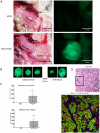A novel protein isoform of the RON tyrosine kinase receptor transforms human pancreatic duct epithelial cells
- PMID: 26477314
- PMCID: PMC4837108
- DOI: 10.1038/onc.2015.384
A novel protein isoform of the RON tyrosine kinase receptor transforms human pancreatic duct epithelial cells
Abstract
The MST1R gene is overexpressed in pancreatic cancer producing elevated levels of the RON tyrosine kinase receptor protein. While mutations in MST1R are rare, alternative splice variants have been previously reported in epithelial cancers. We report the discovery of a novel RON isoform discovered in human pancreatic cancer. Partial splicing of exons 5 and 6 (P5P6) produces a RON isoform that lacks the first extracellular immunoglobulin-plexin-transcription domain. The splice variant is detected in 73% of xenografts derived from pancreatic adenocarcinoma patients and 71% of pancreatic cancer cell lines. Peptides specific to RON P5P6 detected in human pancreatic cancer specimens by mass spectrometry confirm translation of the protein isoform. The P5P6 isoform is found to be constitutively phosphorylated, present in the cytoplasm, and it traffics to the plasma membrane. Expression of P5P6 in immortalized human pancreatic duct epithelial (HPDE) cells activates downstream AKT, and in human pancreatic epithelial nestin-expressing cells, activates both the AKT and MAPK pathways. Inhibiting RON P5P6 in HPDE cells using a small molecule inhibitor BMS-777607 blocked constitutive activation and decreased AKT signaling. P5P6 transforms NIH3T3 cells and induces tumorigenicity in HPDE cells. Resultant HPDE-P5P6 tumors develop a dense stromal compartment similar to that seen in pancreatic cancer. In summary, we have identified a novel and constitutively active isoform of the RON tyrosine kinase receptor that has transforming activity and is expressed in human pancreatic cancer. These findings provide additional insight into the biology of the RON receptor in pancreatic cancer and are clinically relevant to the study of RON as a potential therapeutic target.
Figures







References
-
- Ronsin C, Muscatelli F, Mattei MG, Breathnach R. A novel putative receptor protein tyrosine kinase of the met family. Oncogene. 1993;8:1195–202. - PubMed
-
- Wang X, Hankey PA. The ron receptor tyrosine kinase: a key regulator of inflammation and cancer progression. Crit Rev Immunol. 2013;33:549–74. - PubMed
-
- O'Toole JM, Rabenau KE, Burns K, Lu D, Mangalampalli V, Balderes P, Covino N, Bassi R, Prewett M, Gottfredsen KJ, Thobe MN, Cheng Y, et al. Therapeutic implications of a human neutralizing antibody to the macrophage-stimulating protein receptor tyrosine kinase (RON), a c-MET family member. Cancer Res. 2006;66:9162–70. - PubMed
MeSH terms
Substances
Grants and funding
LinkOut - more resources
Full Text Sources
Other Literature Sources

